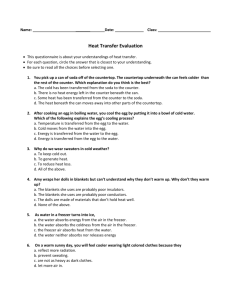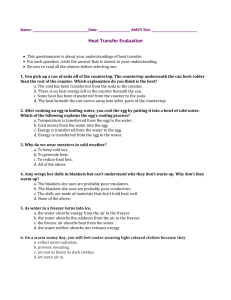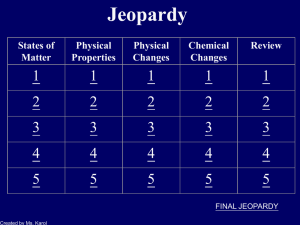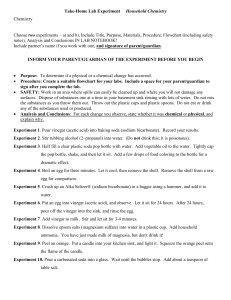Document
advertisement
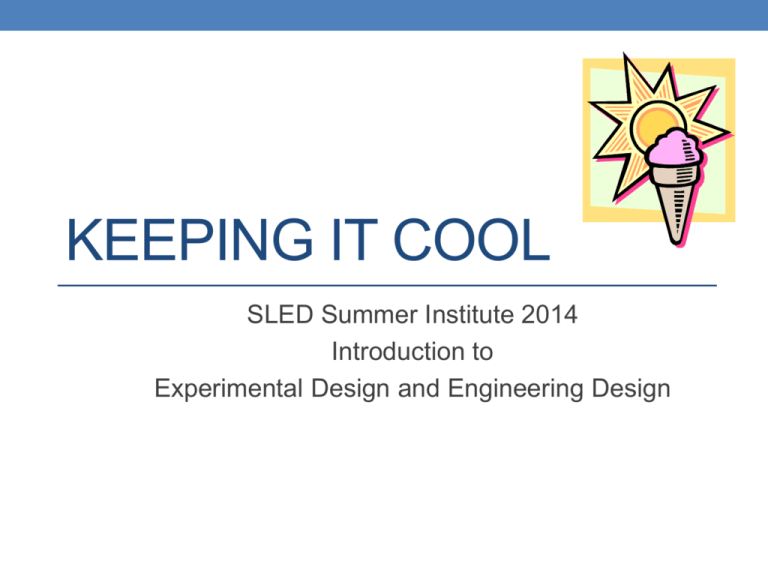
KEEPING IT COOL SLED Summer Institute 2014 Introduction to Experimental Design and Engineering Design Warming Water Two friends put a bowl of very cold water outside on a hot sunny day. The Sun warmed the water. They wondered about the energy of the water. This is what they thought: Ted: “The very cold water had energy. The Sun provided additional energy to warm the water.” Anna: “The very cold water did not have energy. The energy in the warm water came from the Sun.” Which friend has the best idea? Explain why you agree with one friend and not the other. Temperature, Heat, and Thermal Energy Temperature is the measure of average kinetic energy of the particles that make up the object, substance, or material. Heat is the amount of thermal energy that is transferred between two objects. Thermal energy is the amount of kinetic and potential energy in an object or material. Which has more thermal energy? Children’s Alternative Conceptions about Heat and Heat Transfer 1. Cold is a substance that moves. 2. Heat is a substance that rises. 3. Heat is a substance like a fluid, made of 4. 5. 6. 7. particles. Larger ice cubes are colder than smaller ones. Metal is cold, plastic and wood are warmer. Aluminum traps “coldness”; metals hold “cold”. Sweaters warm things. (Albert, 1978; Clough & Driver, 1985; Erickson, 1979; Erickson, 1980) What elementary school students need to know about heat? Students can: • Observe how heat spreads from one object to another and can consider ways to increase or decrease the spreading of heat. • Wonder where the energy comes from that makes things happen. You are going on a field trip and must pack a lunch to take with you. You put a bottle of cold water in your lunch bag in the morning, but when you opened your lunch later that day the drink was warm! What happened? Guiding question Which materials can keep a cup of cold water cold? Materials include: • Aluminum foil • Bubble wrap • Wool felt • Newspaper Notebook entry • Guiding question • Prediction • Procedure • IV, DV, Control • Data • Results • Conclusion Word Bank Heat Cold(er) Warm(er) Temperature Increase Decrease Transfer Present results • What were your team’s predictions? • What were your team’s results? • How can you explain your results? Design Challenge The Boiler Treat Company (BTC) has started an ice cream flavor of the month club. Each month they will send club members a cup of their latest flavor of ice cream. The ice cream will be shipped overnight to the customer (taking up to 24 hours). BTC would like you to design a way to insulate a box that would keep the ice cream cups (represented by ice cubes) from melting. Also, they would like you to calculate the cost to insulate the box. Design constraints include: • The size of the box • The materials available Notebook Entry • Problem (goal, criteria, constraints, client, end user) • Individual Plan • Team Plan • Data Table • Results from testing with an explanation • Re-design Word Bank Heat Cold(er) Warm(er) Temperature Increase Decrease Transfer Organizing your data Description A B C D Mass of two empty cups Mass of two cups with ice Mass of ice [B – A] Mass of two cups with ice* E Mass of remaining ice [D – A] * Remove any water from cup(s) Mass (g) Communicate Results • Present your team plan • Share results from performance testing • Did your team meet the client’s needs? • Based on what evidence? • What is one strength of your design? • What is one weakness of your design? What is the Engineering Design Process? Design is the approach engineers use to solve engineering problems—generally, to determine the best way to make a device or process that serves a particular purpose. • Design is not a linear, step-by-step process. • Design is an iterative process. SLED Model for Engineering Design IDENTIFY PROBLEM IMPROVE AND RETEST COMMUNICATE RESULTS SHARE AND DEVELOP A PLAN CREATE AND TEST What is the problem? What is the setting? Who is the user or client? What are the constraints? IDENTIFY PROBLEM How will you improve your solution? What are the results from your retest? Which solution best addressed the problem? IMPROVE AND RETEST COMMUNICATE RESULTS GATHER FEEDBACK How did your model, prototype, or solution perform? What were your results? What feedback did your team receive? How will you use this feedback to inform your model or solution? What kinds of scientific concepts could explain your results? SHARE AND DEVELOP A PLAN What are your ideas? What are others’ ideas? What materials will you need? What will your team measure? How might your scientific knowledge inform your design? CREATE AND TEST How will your team create a prototype, model, or solution? Does your solution match the team’s plan? How will you record results from testing? What kinds of scientific concepts could explain your results? Essential Features of Design-based Instruction 1. Client-driven and goal-oriented 2. Constraints 3. Authentic and has a social context 4. Use of materials, tools, and equipment that are familiar to students 5. Allows for many different possible solutions that require students to use evidence to explain their solutions 6. Solutions include either an artifact or process 7. Promotes student-centered, collaborative learning Today’s Big Ideas • Heat transfers in predictable ways. • Heat transfers from areas of high temperatures to areas of lower temperature. • Insulators slow down the rate of heat transfer. • Materials affect the rate of heat transfer. • Different materials vary in their ability to reduce heat transfer. • Materials can be used in conjunction with one another to affect the rate of heat transfer. Today’s Science Content • Heat • Temperature • Heat transfer • Insulator Deconstructing Today’s Lesson • To what extent did we engage in practices similar to the work of a scientist? • To what extent did we engage in practices similar to the work of an engineer? Instructional Activities Engineering Design (Engineering Practices) Experimental Design (Science Practices) • Guiding question • Developed an • • • • experimental procedure Identified variables (independent and dependent) Gathered, organized, and presented data Analyzed and interpreted the data Made claims based on evidence • • • • • • Identified the problem Goal-oriented Worked within constraints Set criteria Brainstormed solutions Developed an individual and team plan • Constructed, tested, and analyzed the performance of your prototype • Communicated results • Re-designed Heat Transfer Assessment 1. You pick up a can of soda off of the countertop. The countertop underneath the can feels colder than the rest of the counter. Which explanation do you think is the best? A. B. C. D. The cold has been transferred from the soda to the counter. There is no heat energy left in the counter beneath the can. Some heat has been transferred from the counter to the soda. The heat beneath the can moves away into other parts of the countertop. Answer 1. You pick up a can of soda off of the countertop. The countertop underneath the can feels colder than the rest of the counter. Which explanation do you think is the best? A. B. C. D. The cold has been transferred from the soda to the counter. There is no heat energy left in the counter beneath the can. Some heat has been transferred from the counter to the soda. The heat beneath the can moves away into other parts of the countertop. 2. After cooking an egg in boiling water, you cool the egg by putting it into a bowl of cold water. Which of the following explains the egg’s cooling process? A. B. C. D. Temperature is transferred from the egg to the water. Cold moves from the water into the egg. Energy is transferred from the water to the egg. Energy is transferred from the egg to the water. Answer 2. After cooking an egg in boiling water, you cool the egg by putting it into a bowl of cold water. Which of the following explains the egg’s cooling process? A. B. C. D. Temperature is transferred from the egg to the water. Cold moves from the water into the egg. Energy is transferred from the water to the egg. Energy is transferred from the egg to the water. 27 3. Why do we wear sweaters in cold weather? A. B. C. D. To keep cold out. To generate heat. To reduce heat loss. All of the above. 28 Answer 3. Why do we wear sweaters in cold weather? A. B. C. D. To keep cold out. To generate heat. To reduce heat loss. All of the above. 4. Amy wraps her dolls in blankets but can’t understand why they don’t warm up. Why don’t they warm up? A. B. C. D. The blankets she uses are probably poor insulators. The blankets she uses are probably poor conductors. The dolls are made of materials which don’t hold heat well. None of the above. Answer 4. Amy wraps her dolls in blankets but can’t understand why they don’t warm up. Why don’t they warm up? A. B. C. D. The blankets she uses are probably poor insulators. The blankets she uses are probably poor conductors. The dolls are made of materials which don’t hold heat well. None of the above. 5. As water in a freezer turns into ice, A. B. C. D. The water absorbs energy from the air in the freezer. The water absorbs the coldness from the air in the freezer. The freezer air absorbs heat from the water. The water neither absorbs nor releases energy Answer 5. As water in a freezer turns into ice, A. B. C. D. The water absorbs energy from the air in the freezer. The water absorbs the coldness from the air in the freezer. The freezer air absorbs heat from the water. The water neither absorbs nor releases energy 6. You have a can of soda in your lunchbox that you want to keep cold. Which material will work best to keep it cold? A. B. C. D. Aluminum foil wrapped around the soda because metals transfer heat energy easily. A paper towel wrapped around the soda because paper soaks up the moisture. Wax paper wrapped around the soda because wax paper traps the moisture. Your wool sweater wrapped around the soda because wool traps air. Answer 6. You have a can of soda in your lunchbox that you want to keep cold. Which material will work best to keep it cold? A. B. C. D. Aluminum foil wrapped around the soda because metals transfer heat energy easily. A paper towel wrapped around the soda because paper soaks up the moisture. Wax paper wrapped around the soda because wax paper traps the moisture. Your wool sweater wrapped around the soda because wool traps air.
